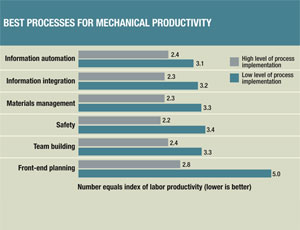Want to achieve a 50% boost in construction craft productivity? The Construction Industry Institute aims to fulfill this ambitious goal with a six-year craft-productivity research program.
The first phase, focused on mechanical trades, was one of CII’s seven research projects wrapping up in 2009, according to CII Chairman John Dalton, who also is COO for Mustang Engineering, Houston. “The study gives us the benchmarking and metrics to check that craft construction productivity is properly planned and implemented.”
The study was built on prior research that included a survey of nearly 2,000 craft workers to assess how dozens of different factors impact their productivity. It also incorporated benchmarking data from more than 90 projects, as well as innovation workshops and field studies.
Researchers found that projects with more advanced information automation and integration systems and processes for materials management, safety, team-building and front-end-planning experienced better labor productivity. “Front-end planning was found to have the strongest relationship with improved productivity,” says team member Shannon D. Hopkins, site construction manager with Eastman Chemical Co., Kingsport, Tenn. It is best to “involve construction craft planning early and benchmark the level of implementation,” Hopkins adds.
The study quantifies the relationship between safer projects and productivity. Best practices cited for mechanical trades include safety meetings, audits conducted by corporate safety personnel and maintaining adequate ratios of craft workers to on-site safety staff. Case studies identified key methods for increasing productivity. One CII member company found laser scanning on a facility upgrade project yielded a more than 80% reduction in design time and a 98% reduction in the number of field travel days, says Mark Stofega, construction support engineer in the Greenville, S.C., office of Fluor Corp. “More importantly, this results in less field rework for our craft,” he says.
Future phases of the study will focus on electrical, concrete and structural steel, culminating with a road map for implementing specific best practices.
Modular construction has transformed the shipbuilding industry, and another CII study attempts to translate similar techniques to buildings. The strategy is attractive to contractors and especially owners since it lowers costs, increases quality and cuts schedules, according to the study.

DALTON
One key adoption from shipbuilding is the interim product database, which contains products and production processes that are easily reconfigurable for each project. Standardized modules and sub-assemblies are grouped into families by similarity and zones (such as plant zones for mechanical systems or public zones for lobbies) and then built in a manufacturing-type facility to be shipped to the jobsite for installation.
Researchers identified numerous barriers to this type of construction, such as code variations in different jurisdictions and the need for customization. Module applications should be scalable and repeatable and “not be approached as one-off project solutions to facilitate a specific project,” says David Behrens, chief construction engineer with Bechtel Systems and Infrastructure, a division of San Francisco-based Bechtel Group. Contractors will have to increase capital investment to set up infrastructure jigs and templates, but per-unit cost of buildings will drop, says the study.
Another CII study examines the looming crisis in the estimating profession. In a survey of 228 contractors and owners, 84% expect a shortage of cost estimators within five years, and 67% are experiencing shortages right now, despite the lagging economy. Challenges include ensuring that universities teach the right skills and that there is an efficient transfer of knowledge from experienced estimators to new hires. To build a sustainable future workforce, estimators within the industry and those just entering it need a clear career development path, says researcher David H. Jeong, assistant professor at Oklahoma State University’s School of Civil and Environmental Engineering.





Post a comment to this article
Report Abusive Comment